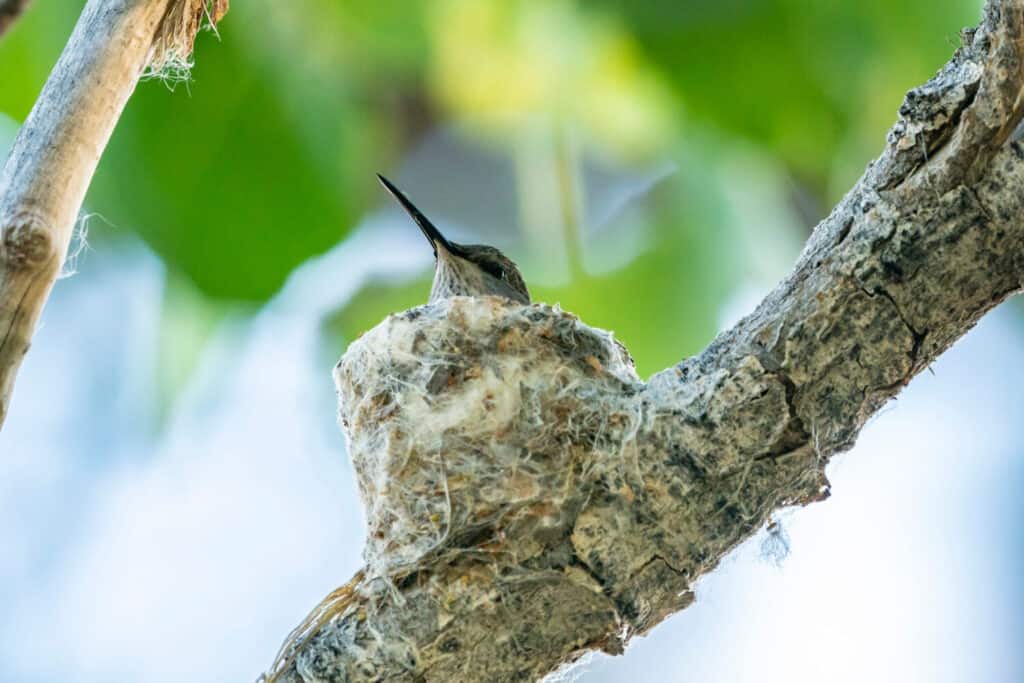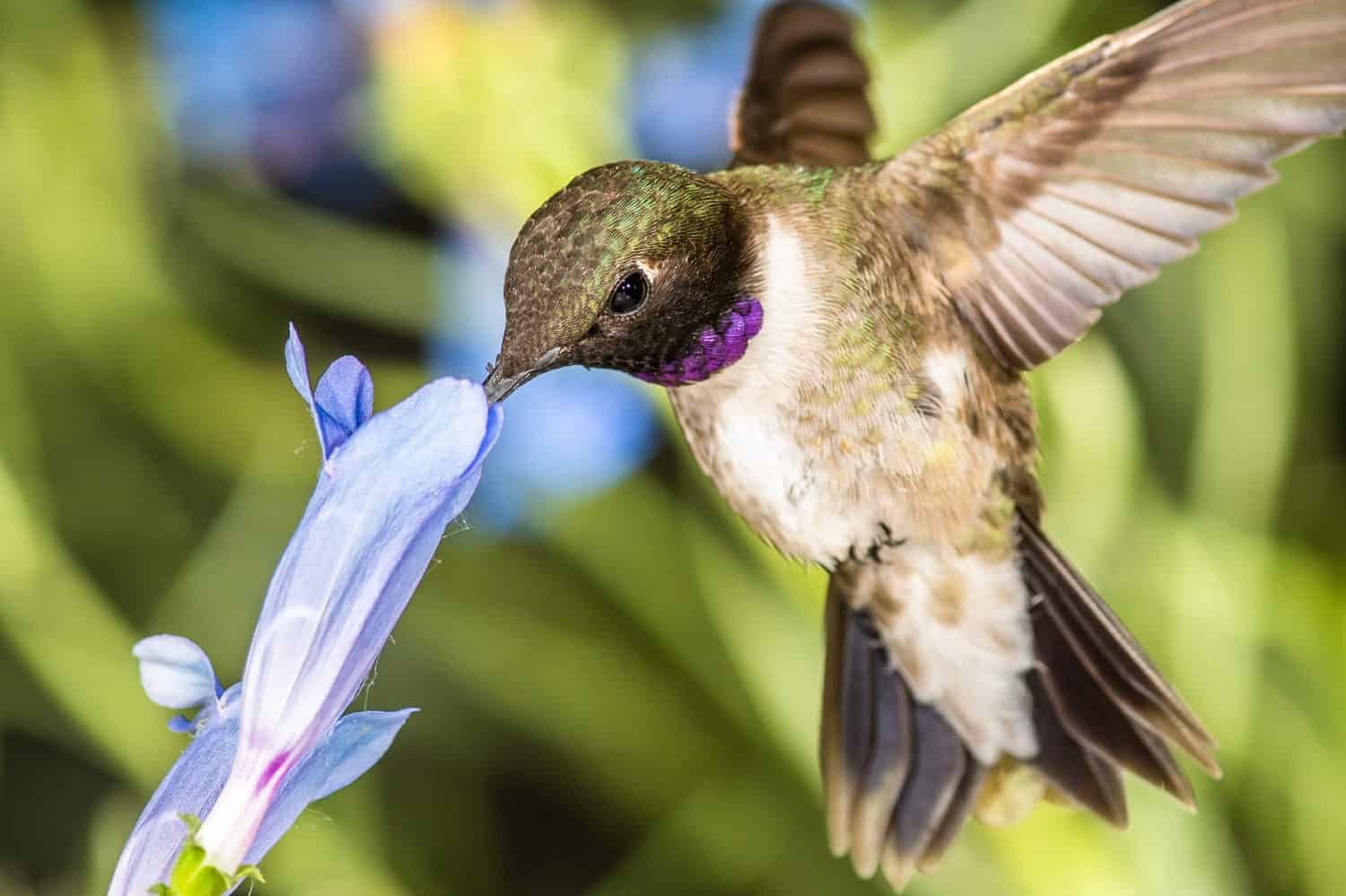Hummingbirds are one of the most birds out there. They are quick and beautiful birds that love to drink the nectar of flowers. There are also many different kinds of hummingbird species out there, each with their own little quirks and specialties. One of the best differences among the species is the colors and patterns. There are so many types of beautiful hummingbirds, that it makes you wish you could keep them as a pet. With that, the black-chinned hummingbird (Archilochus Alexandri) is one of the many beautiful hummingbirds out there! If you’re a bird watcher, or simply just want to learn more about hummingbirds, keep reading below to learn more about the black-chinned hummingbird, where it can be found, and how to identify it!
Identification

The black-chinned hummingbird has a beautiful iridescent purple stripe on its chin!
©rck_953/Shutterstock.com
As the name implies, the black-chinned hummingbird gets its name from its physical appearance. The name, more specifically, comes from the male black-chinned hummingbird. Males have black feathers on their backs, white or grey feathers on their stomachs, and their heads have black feathers with metallic purple feathers underneath their beaks. The purple metallic feathers can often be mistaken for black given the amount of pigment in the feathers or in the lighting as well, so make sure to get multiple angles! Male black-chinned hummingbirds are slimmer in appearance, but both male and female birds are roughly 3.3-3.8 inches in length. They are tiny little birds, so they may be hard to see at first. Their wingspan is larger than the length of their body though, typically around 4-4.75 inches long!
The female black-chinned hummingbird is more stout in appearance. Females also have dull metallic green back feathers, white feather stomachs, and long beaks that reach 3/4s of an inch long. Both female and male black-chinned hummingbirds have black beaks and are on the longer side for many hummingbirds!
Some tinier points for identification are things such as posts or under the feathers. The male black-chinned hummingbird will have small white spots behind its eyes, even until adulthood. You may be able to see these in female hummingbirds as well, but most of the time only in adolescence. Immature males and females will have whitish or purplish feathers on the underside of their wings, with the tip of them being pure white. When you see a black-chinned hummingbird flying around, look out for these small details!
Behavior
Black-chinned hummingbirds are similar to many other hummingbird species out there in behavior. The first thing to note is the way they hover. These hummingbirds will hover around or near flowers when they are ready to drink the nectar. Moments like these are the best times to get a good picture or sighting of these birds. The black-chinned hummingbirds will also perch very high in trees and other surfaces. Given their size, they are very easy prey, so having a high stance gives better surveillance of the area or territory they are in! They are hard to spot from so far off the ground, so it may be useful to use binoculars!
When they see competitors in their territory or predators, these birds and their speed will chase them down, or outspeed them in general! They also eat any kind of flying insect, so they are constantly on the lookout! When they are courting other black-chinned hummingbirds, the male hummingbird will freefall drop anywhere between 66-100 feet! This is to impress the female hummingbirds. Given their behaviors, be sure to look out for any hummingbirds meeting this description!
Where to Spot One

Hummingbirds often nest in high trees, making them hard to see from the ground!
©Danita Delimont/Shutterstock.com
Black-chinned hummingbirds are often found in the western region of the United States. These birds are known as something called “habitat generalists.” Simply put, this means that the birds are able to thrive in many different environments and on a large number of diets as well! This means that the black-chinned hummingbird can be found in both urban and very rural areas, as long as there is flower nectar available. They can be most often found in places such as Nevada and Idaho in the summer, and in the winter, they will migrate to the Gulf Coast! As they are extremely adaptable, they can be found in both the lowland deserts and forests of the western half of the States, making them fairly common!
As they set up nest in taller trees, if there are only smaller trees, or none at all, you will have a hard time finding them there! When bird watching, make sure to bring a pair of binoculars so you can get the best view possible!
Diet

Hummingbirds can fly extremely fast, making them hard to see with the naked eye.
©rck_953/Shutterstock.com
There is so much to learn about the black-chinned hummingbird! Besides just their appearance and habitat, there are some other ways to get a quicker and easier view of them. By understanding their diet, you may get a better insight as to where they may be around, especially in your local area!
Most of their diet comes from nectar in flowers! A hummingbird’s tongue is as long as their beak is in length! When they drink the nectar of flowers, they drink the nectar from the flower center. During this process, they also pick up pollen which is spread to other flowers! This allows for more flowers to grow and become fruitful! Black-chinned hummingbirds will also eat small insects around them, often found in trees, flying, or around the flowers they drink nectar from!
How to Attract
If you’re looking to attract hummingbirds in general to your house or area, there are ways to do so! The easiest way is to just plant as many flowers as possible! This will make your house popular amongst the hummingbirds, and they will surely flock to get their share of the nectar! There are also commercial feeders available where you can mix in sugary water mixes that attract the hummingbirds! Hummingbirds get most of their energy from the sugar they drink from nectar, so it’s important to provide as much as possible! Hummingbirds have their own quirks too, and are most attracted to flowers that are bright orange or red in color! These colors stand out the most to them, are are easily noticeable. They also love it when the flower is more tube-shaped! This is because it is easier to gather the nectar from the flower given the shape of its beak! Hummingbirds are amazing creatures, and by taking proper steps, can be easily attracted to your garden!
Fun Facts
The black-chinned hummingbird is an amazing creature! They have so much beauty and uniqueness to them that makes them so special! With that comes a wonderful list of fun facts! One of the most interesting is that they are able to drink up to 80% of their body weight in nectar every day! They love their sugar, and need it to be able to flap their wings as quickly as they do! No wonder they always fly so quickly between flowers. Hummingbirds in general are able to flap their wings up to 80 times per second! This makes the process almost impossible to see from the naked eye, and you will probably need a camera to see the precise process. They also can fly extremely fast! They can speed around somewhere between 20-30 miles per hour, quicker than some speed limits! These amazing creatures are amazing to view, and are surely popular in the bird-watching community!
Summary
The black-chinned hummingbird is one of the most amazing hummingbirds out there! They are super special in their own special ways, especially in appearance. With the male birds having a beautiful purple stripe and the females having green feathers all along their backs, these hummingbirds are a sight to behold! They are also all across the western region of the United States, making them easy to see! Whether you are just curious about hummingbirds, or you want to go bird-watching for them, these hummingbirds are beautiful birds and are worth the effort to see!
The photo featured at the top of this post is © rck_953/Shutterstock.com
Thank you for reading! Have some feedback for us? Contact the AZ Animals editorial team.







